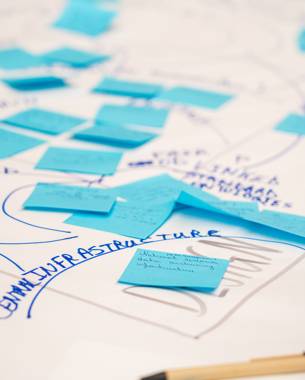
Step 1
The first step is: Start with a happy flow. A clear starting point (someone feeling hungry) and an endpoint (no more hunger).
As you can see, everything goes well, smoothly and there are no complications.

Most researchers are only knowledgeable about the front-side of a DMP: filling it in. However, many stakeholders have a role regarding the DMP, often unseen and regarded as a “black box”. Therefore, Nele Schouteden and colleagues (imec & the FRDN-Knowledge Hub) took it upon themselves to create clarity by drawing out the DMP business process. This would enable everyone involved to get an overview of and insight in this complex, multi-layered topic. And with insight, comes power.
Spoiler alert: it is not that difficult. That said, know that an iterative approach is necessary.

The first step is: Start with a happy flow. A clear starting point (someone feeling hungry) and an endpoint (no more hunger).
As you can see, everything goes well, smoothly and there are no complications.

The second step is of course: adding the drama: “What if?”
What if ... you can’t wait for dinner to be ready because your stomach is digesting you from the inside? Add a different route, based on a clear-cut decision to be made (can it wait?).

What if ... dinner or a snack wasn’t enough to satisfy your nutritional needs? Add a loop!

What if ... there are several people depending on you to provide them with food?
Other “what if?” scenarios can be added of course: what if you’re a lousy cook? (You can order takeaway).
Then, run by other stakeholders and ask for their opinion on the process. Implement their feedback (What if it’s 6 o’clock in the morning? Breakfast should be the outcome, not dinner!), change phrasings, go to a higher abstraction level, specify where needed, switch up the order of steps or scratch them all together.
This scenario can easily be set up in dozens of diverse ways by different people – who’s right? Everybody is, keep in mind that the schematic presentation of a business process is a tool, not a goal.
That’s why we’ve kept our DMP-process to an abstraction level where all participants of the workshop could agree upon and left it to them to modify it where appropriate to accommodate this tool for their own institution and for their own goals.
So what were and are the benefits of this endeavour?
Click on the link here: Workshop Knowledge Hub Process Flow 2023 (zenodo.org)


Nele Schouteden
Research & Development Data Manager at imec | Problem Solver | Beekeeper
Nele Schouteden is a Research & Development Data Manager at imec known for her enthusiasm in tackling seemingly dull subjects. With a passion for problem-solving, she excels at finding innovative solutions. Nele has a unique talent for transforming casual conversations into captivating lessons, whether about supersocial insects or highly mutative worms. She holds a Ph.D. in nematology and is an active member of the Knowledge Hub Program Committee. Nele is also a new member of the Flemish Research Data Network Coordination Hub, aiding in the coordination of research data initiatives.